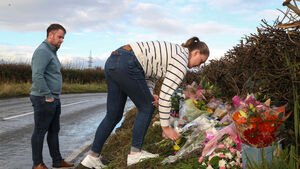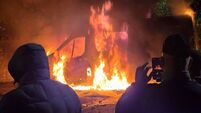The struggle to cope with the death of a child

Friends place flowers at the scene of the crash on the Ardee Road, near Dundalk, that claimed the lives of five people in their early twenties. Picture: Colin Keegan/Collins
During November I visit cemeteries. In Ballycastle cemetery, where my parents are buried, I spend time moving meditatively along the headstones and reading the spare words that attempt to record lived lives. In Doonfeeney cemetery too, where three siblings rest in the grave of my paternal grandparents. My sisters (Catherine and Anne) and my brother (Anthony) triplet children who lived the shortest of short lives but whom we fondly remember.
Remembering too relatives, neighbours and childhood friends. This year remembering a classmate in the ‘academy on the Glen Road’, Tommy Tighe, Laragan, the most recent addition to their number.
Praying too when a memory suddenly unfolds of times and seasons long past, of people and places, now fading into the mists of time.
Reflecting too on how many who were younger than I am are already gone to God and on the inevitably limited years of my own life – now that I’m on the wrong side of the biblical three-score and ten. With the inevitable diminishments of old age, progressively we find ourselves speeding towards the final curtain.
Here and there I pause when a headstone registers the death of a young child and ponder what that must have meant for parents and siblings who have had to deal with the enormity of the loss and pain that attended that life-defining event.
Inevitably, ‘Mid-Term Break’, the most popular of Seamus Heaney’s poems, comes to mind. In his early teens, his three-year old brother, Christopher, was killed crossing the road. Seamus was then a boarder in secondary school and neighbours brought him home for the funeral:
The enduring popularity of Heaney’s poem is unsurprising as it has become a ready framework presenting in spare, simple words, the nightmare of grieving parents pining for their dead children. While every child is different and every grief has its own unique pattern, losing a child enlarges the loss and pain because those who travel that journey touch on ‘the tears of things’, the deepest and most elemental experience of life and death. And only those who traverse that gruelling terrain – sometimes for life – can know what it means.
Recently I was gifted a book, . It’s a collection of a dozen essays, in which those who have lost a child tell their stories in the hope that they may help others experiencing a similar grief. And that this might afford an insight to those families, friends and loved ones who witness their suffering to know what to do and what not to do – even to know what to say and what not to say.
Catherine Dunne, an Irish novelist, writes about her second son, Eoin, who was stillborn in 1991. She felt the silence in the ward. She heard a young resident say, ‘No FH’.
'What does it mean?' she asks.
Her doctor Patricia, crosses the room and takes her free hand. She doesn’t need an answer, as Patricia’s eyes fill, over and over.
‘It means,’ Patricia says, ‘no foetal heartbeat. I’m so sorry, Catherine.’
‘The baby’s dead,’ Catherine says, more a statement than a question.
‘Yes,' Patricia says, pressing her hand.
The midwife wraps Eoin in green blankets and hands him to Catherine. He didn’t suffer, the midwife assures her, it was just like going to sleep.
Some days later, Catherine wrote: ‘People told me it would take time. And it did but not in the way they meant. Time was stolen from me; it sneaked away, disappearing around corners while I wasn’t looking. Days lost their definition, blurring sleepily into night. Weeks tumbled one into the other. I washed, dressed, cooked, cleaned, drove, ironed, supervised homework and cried. The one thing I didn’t do was look at the still-open suitcase on my bedroom floor. At all those hopeful packets that I hadn’t the chance to take with me to the hospital. Vests, Babygros, nappies.'
Catherine never knew the restlessness she experienced in the weeks that followed. She walked, paced, fidgeted, round the garden, round the bedroom, round the kitchen table. She wondered why people crossed the street when they saw her. And why conversation was as bright and brittle as glass; and how she should respond to those who told her that she ‘had an angel in heaven’ or that she would have another one, as if babies were not irreplaceable.
At a meeting of ISLANDS (The Irish Stillbirth and Neonatal Death Society), the philosopher/writer, John O’Donoghue gave voice to what Catherine and others were feeling: guilt; a sense of failure; a loss of faith in the future; pure, blind fury and the need to blame someone – God, doctors, someone. Go ahead, rage away at God, O’Donoghue told them, 'He has shoulders big enough to take it'.
Gradually, she began to learn ‘how to step from one island to the next, remaking myself as I go'.
'The wastelands in between become easier to bear because now, at last, they are infinite spaces.’
It is a sea of sadness, a river of optimism, of how fierce are the bonds of love for children: ‘What consumed me above all was not depression. It was the acute sadness of separation, of the loss of hopes and dreams. And having to come to terms with the unthinkable: parents are not supposed to die before their children.'
In time, Catherine discovered, grief ceased to ambush her; it moves to a different register; it acquired a new tone; it came from a different place; a place where consciousness of loss was overlaid by an engagement with the present.
Say a prayer, if that is part of what you do, for the parents of those struggling to cope with the death of their children, as are the parents of the young who died so tragically in County Louth last week.
- is edited by Peter Stanford and is published by Continuum.






